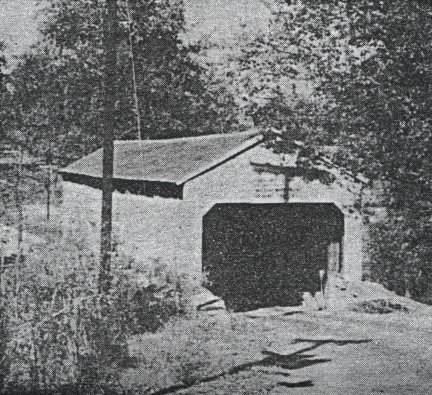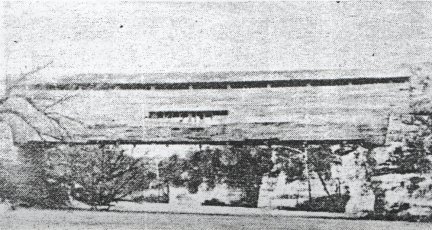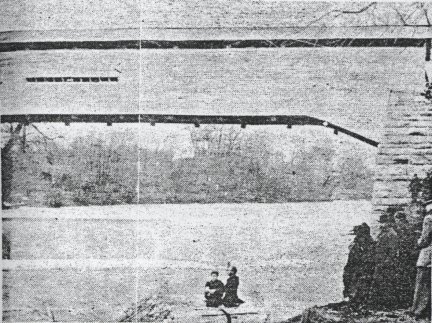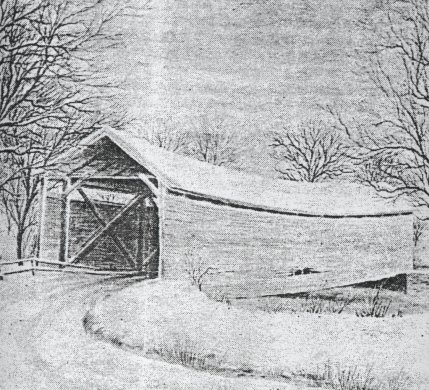|
At
one time there were five covered bridges in Monroe
County. Time and tide—mostly tide--have taken their
toll and today there is only one covered
bridge--preserved as an historical treasure, not for
vehicular traffic.
That
one is Union Covered Bridge and is dealt with in
another story.
The
five bridges in Monroe County were built by Joseph C.
Elliott and his son, William B. Elliott, from 1856 to
1871.
Even
though the first recorded type of covered bridge was
built across the Euphrates River in Babylon in 783
B.C., the bridges have become symbolic of early
Americana.
Many
covered bridges were designed by Theodore Burr,
descendant of Aaron Burr, who has been called the
father of American Bridges. Other pioneer builders of
covered bridges were Ithiel Town and William Howe. But
Burr had the most influence on the builders of the
county bridges, Joseph and William Elliott.
The
four bridges that have been destroyed are the
Stoutsville bridge, Mexico bridge, Santa Fe Bridge and
Paris bridge.
|

The
Paris covered bridge was built in 1857 over
Middle Fork and destroyed by flood waters in
August 1958
|
|

The
Santa Fe covered bridge was built in 1859
and swept away in 1926.
|
The
Stoutsville bridge was built on the North Fork of Salt
River on Highway 24 east of Paris in 1851-57.
|

The
Stoutsville covered bridge was built in
1851-1857 over North Fork on Highway 24 east
of Paris and razed in 1932 to make way for
an iron and steel bridge. It was the only on
of four in Monroe County not destroyed by
flood waters. This vintage photo shows Rev.
Robert Colborn performing a baptism below
the bridge. The ceremony took place in the
dead of winter. Ice fourteen inches thick
had to be cut at the spot where the baptism
is being performed.
|
It
was razed in 1932 so that an iron and steel bridge
could be built across North Fork. An interesting note
about the tearing down of this bridge is that it was
done by Carl Elliott, project engineer for the
Missouri Highway Department, a grandson of the man who
built the bridge.
This
bridge was called the Elliottvile bridge as at one
time there was a small settlement south of the bridge,
known as Elliotville.
There was an ice house, country store and a few
houses. All have now disappeared. This is the only one
of the four vanished bridges that was not destroyed by
flood waters.
At
a cost of $4000 the Mexico covered bridge was built in
1859, three and one-half miles southeast of Paris
across Elk Fork of Salt River. A winding gravel road
off Highway 154 east of Paris led to the
bridge.
|

The
Mexico covered bridge located 3 1/2 miles
southeast of Paris over Elk Fork was built
in 1859 and destroyed in 1967.
|
Water
took its toll of ills bridge in the flood of July 9,
1967, when Elk Fork rose and water carried the bridge
downstream. Before its destruction young people would
gather at the bridge, sweep it clean and
play all sorts of games there.
Also
in 1859 the Santa Fe covered bridge was built a short
distance from Santa Fe. This cost only $2000 as
Elliott had to build only one abutment. One end of the
bridge rested on a rock bluff.
Again
flood waters took their toll and this bridge was swept
down the stream June 19, 1926.
In
the wintertime local boys would haul snow and dump it
on the bridge, then slide down the hill across the
bridge.
One
time a young couple, Carl Hawkins and Lila Davis, were
coasting down the hill and entered the bridge just as
Sidney Mc lhany rode a horse in the other end. They
were going too fast to stop and simply coasted under
the frightened horse between his feet. There is no
record of any injuries.
The
last of the four vanished covered bridges was the
Paris one. It was built in 1857 over Middle Fork of
Salt River, three blocks from the courthouse. It was a
Burr Arch structure, 100 feet long.
In
August 1958 it too was destroyed by flood waters of
Middle Fork. Crowds of people followed Middle Fork to
see the old bridge lodged a mile downstream.
Charles
Howell, who had been born and raised on Salt River,
salvaged some of the wood and made souvenirs.
The
bridges were things of beauty. Joel M Vance
wrote in 1968 about the ‘peaceful, other-world
quality about it as the shadows of evening lengthen.
Listen to the water curling over the ford on Salt
River and observe the birds getting in their final
vocalizing before going to roost and you can imagine
you are a hundred years back in time.”
Only
Union covered bridge stands today-a visible reminder
of a time and way that was.
|